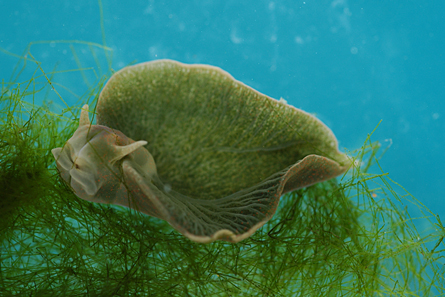Making the most of a meal
Sea slug swipes recipe for food-producing chemical from algae it eats
Share this:
- Share via email (Opens in new window) Email
- Click to share on Facebook (Opens in new window) Facebook
- Click to share on X (Opens in new window) X
- Click to share on Pinterest (Opens in new window) Pinterest
- Click to share on Reddit (Opens in new window) Reddit
- Share to Google Classroom (Opens in new window) Google Classroom
- Click to print (Opens in new window) Print
 |
|
The sea slug Elysia chlorotica feeds by sucking the insides out of strands of algae. The slug has taken in the algae’s key tools for using sunlight to help produce food. Researchers now say the slug also can produce — and not just steal
|
| Nicholas E. Curtis and Ray Martinez |
For decades, people have been telling each other, “You are what you eat” — meaning that the nutrition in a person’s diet affects his or her health. It doesn’t mean, for example, that if you eat a plant, you become a plant.
At least, not for people.
For a certain kind of sea slug, however, those words are more than just a reminder to eat well. The Elysia chlorotica is a sea slug that looks like a leaf and eats by sucking the insides out of strands of algae. (Yum!) These algae, like plants, get their food by using sunlight to help make sugar.
At a recent meeting of scientists, a biologist named Sidney K. Pierce reported a surprising observation in these algae-eating sea slugs. Pierce does his research at the University of South Florida in Tampa.
Pierce already knew that these sea animals, just like plants, have the right chemical tools to turn sunlight into food. Surprisingly, now he’s learned that the sea slugs aren’t simply stealing what they need to do this from the algae. They’ve also stolen the recipe for how to make chlorophyll, a chemical that is vital to the process, and can make chlorophyll themselves. In other words, they have started to behave like their food.
“This could be a fusion of a plant and an animal — that’s just cool,” John Zardus told Science News. Zardus is an invertebrate zoologist at The Citadel in Charleston, S.C. Invertebrates are animals that don’t have backbones (like slugs), and zoology is the study of animals — so Zardus studies animals without backbones.
Inside their cells, plants have tiny structures called chloroplasts. These chloroplasts turn carbon dioxide and water into sugar using sunlight and a chemical called chlorophyll. (The first part of the word comes from the Greek word chloros, which means “green” —chlorophyll gives green plants their color.) The process of the chloroplasts using chlorophyll to make sugar is called photosynthesis.
Like plants, the algae that get eaten by the sea slugs also use photosynthesis. When Pierce’s slug eats algae, it separates out the chloroplasts. Instead of digesting and excreting the chloroplasts, the sea slug absorbs them inside its own cells. Pierce and his colleagues already knew that once a slug has chloroplasts inside its cells, it can use photosynthesis to make food — which means it may not even have to eat for the rest of its life (about a year). Other animals, like coral, have been known to stash cells containing chloroplasts and use some of the food they make.
But the chloroplasts use up the chlorophyll during photosynthesis, and a fresh supply is needed. Where does it come from? One idea was that when an animal absorbed the chloroplasts, they came with a lifetime supply of chlorophyll. But as it turns out, that’s not the case with these sea slugs. Pierce and his colleagues found that unlike other animals, sea slugs can make their own chlorophyll — which means that they have stolen more than just the chloroplasts.
Deep inside almost every living cell are genes, which function like recipes for how to make what the organism needs. A plant has genes, for example, that contain the instructions for chlorophyll. As it turns out, so do sea slugs — as Pierce and his colleagues are discovering.
So sea slugs not only ingest the chloroplasts — they’ve also “adopted” part of these genetic instructions from their food. In other words, these sea slugs are truly becoming what they eat. Even stranger — it’s the first time the worlds of algae and animals have seemed to overlap like this.







